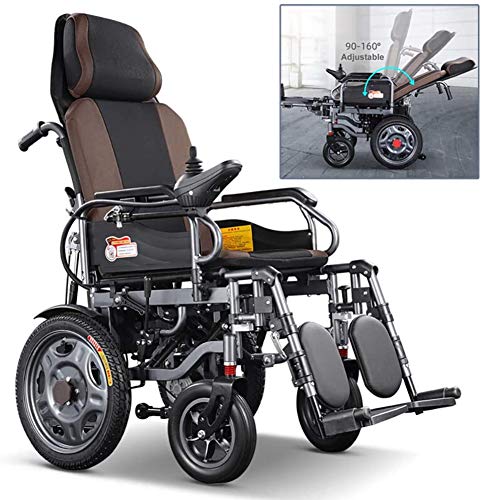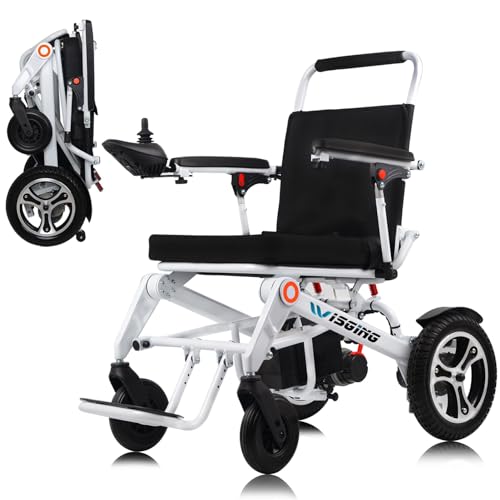17 Reasons You Shouldn't Beware Of Electric Wheelchair With Joystick
페이지 정보

본문
 Electric Wheelchair With Joystick
Electric Wheelchair With Joystick Joysticks for power wheelchairs can increase their ease of use and independence. However, standardized joysticks can be incompatible with the individualized features of hand disorders.
Joysticks for power wheelchairs can increase their ease of use and independence. However, standardized joysticks can be incompatible with the individualized features of hand disorders.This study assessed the efficacy and satisfaction of customized power wheelchair Joysticks made with 3D printing. Modified power-mobility indoor driving assessment (PIDA), National Aeronautics and Space Administration task load index, and the psychosocial impact of assistive devices scale were employed for evaluating.
Control
The control system of a power wheelchair comprises two essential components: the joystick and the electronics (also called the controller). Standard joysticks are mounted on either the left or right side of the chair, while more sophisticated rehab chairs come with swing-away mounts that permit the joystick to be moved to the middle of the seat.
The manner in which the joystick is placed and used is essential to its effectiveness for a user. For instance when a person has a significant amount of tremors, then it is essential to ensure that the joystick is designed such a way that these movements will not trigger accidental activations of the chair. Standard EPW joysticks generally use proportional input devices, which respond to the amount of deflection on the gimbal in order to determine the direction of the chair (similar to an accelerator pedal or video game controller).
There are many alternative control options for power wheelchairs, that require only a little force to activate. These include switch controls sip and puff control as well as head array systems and chin controls. While some of these special controls require an additional interface to connect them to the wheelchair, a lot are compatible with the latest generation of joysticks, which have integrated Bluetooth into their handles.
Some standard wheelchair joysticks even come with a screen to display the current status of the system and provide feedback to the user. This is especially useful for people with cognitive or visual impairments. Other joysticks with advanced technology have the ability to control many different devices like environmental controls and even a TV or tablet.
Regardless of the technology the joystick is as useful as it is comfortable for the user to use. This is why it is important to consider the size and positioning of the joystick's buttons to ensure that they are easy to access. It is also essential to think about the sensitivity of the joystick, which can be set to a variety of levels based on the individual needs of the client.
Comfort
A joystick-controlled wheelchair with electric motor has many advantages that a manual chair does not offer. They reduce fatigue due to operational factors and can travel longer distances than manually operated chairs electric. They can also be used in areas that have less space or more difficult terrain like outdoor slopes and uneven surfaces. With this added mobility users will experience a freedom of movement that gives new life to their lives and reminds them of how great it is to be able to move around independently.
There are numerous different power wheelchairs on the market each with its own unique features. The amount of bells and whistles that a particular model features will depend on the preferences of the user and needs. The most commonly used features are:
Controls on an electric wheelchair equipped with a joysticks can be adapted to meet the needs of each individual. This includes the type of knob or handle, or ball, and how it is mounted. Joysticks are usually located at the end of the armrest of the driver's chair, while others are placed in the front or back of the seat to make it easier for the attendants to reach. They may also be mounted on the sides of the seat for people with limited shoulder range or muscles that are weak.
Other features are more personalized like the design and size of the joystick screen. Some are backlit or in colors that are easier to read for those who have low vision. Other models have auxiliary modes that offer audio or visual cues for navigation. Other models may include odometers, clocks and indicators of battery charge.
A joystick's ability to maneuver in a limited turning radius is also important. The best models will have a smaller turning radius, which makes it easier to maneuver through obstacles and narrow spaces, such as hallways. This tight turning radius makes it easier to navigate in public areas and stores. This tight turning circle is especially beneficial for those with mobility issues, like cerebral palsy, or other mobility issues such as multiple sclerosis, ALS and Huntington's Disease. brainstem or spinal cord injury stroke.
Safety
Power wheelchairs are designed with safety in mind. They are equipped with reliable brake systems which can slow down speed rapidly when the user depresses the joystick control lever. They also have anti-tip wheels at the rear that help prevent the chair from tipping backward.
The most popular type of joystick is a proportional control which is similar to accelerator pedals as well as video game controllers in that the more the joystick moves away from its center the more quickly the wheelchair moves. Joysticks that are proportional require a strong hand and a healthy sense of proprioception. Standard joysticks are mounted on the armrest. However, there are a variety of special controls that put the controls on the middle or side of the seat.
Certain people might not have enough muscle strength to deflect a joystick handle, even with special rigging. People with spasticity might have a problem because their muscles can become stiff or atrophy. In these instances, a head control unit that converts the movement of a user's head into a command for the wheelchair might be a better option.
Another factor to consider is the size and placement of the joystick's buttons. If the buttons are far forward or hard to reach, they may hinder the seating position of the user and create stress on the hands. If the joystick is too far back, it can be difficult to maneuver the chair or turn the wheels.
Finally, an electric wheelchair is best used with the seatbelt fastened. Seatbelts must always be fastened when using an electric wheelchair heavy duty wheelchair. The fastest wheelchairs can travel up to 8mph. Batteries should be charged frequently and at least every night. This will ensure that they last longer and maintain their effectiveness. You should also have your chair maintained regularly to ensure that all parts are operating effectively.
Accessories
Joysticks are a key component of power wheelchairs and can be improved by a variety of accessories. These range from basic switches to more sophisticated interfaces that can be connected to communication devices, or external environmental control units. A higher-end power wheelchair usually comes with several controller components that can be utilised and configured to meet the requirements of a specific client. For example the non-expandable controller would typically only accept the proportional joystick as an input device, whereas an expandable controller may allow sip and puff controls, special switches and head array systems. Certain advanced controllers are able to operate up to two power seating actuators that can alter the angle and position of the seat.
The most basic kind of joystick commonly prescribed in the clinic is a proportional control, also called a motion sensing joystick. This kind of joystick, similar to accelerator pedals in cars and video game controllers responds to the force exerted on the stick by increasing its output (i.e. wheelchair speed) the further the stick is moved away from center. This requires a good deal of dexterity as well as a strong proprioception for efficient use.
While the technology that is in use today is able to compensate for minor variations in amplitude during EPW driving but it is not able to recognize and adapt to more severe, unintentional movements, like those caused by greater amplitude tremors or involuntary movements that are not accompanied by conscious intent like athetosis.5 Until we can develop and implement new technology that can accurately detect and adjust to these types of unintentional movements, many sufferers with diseases such as athetosis, MS, ALS or spinal cord injuries won't be able to safely operate an electric amazon power chairs - learn more about Olderworkers, chair.
Most wheelchairs can be customized and programmed by a clinician. These parameters can be used to alter the torque generated by the motor and altering the speed of the chair. They can also be used to determine the dead zone which is the distance in which the EPW will not produce an output. Some controllers also allow the clinician to save backup programs. This is useful in an emergency situation or if a patient's symptoms change.
- 이전글The History Of Mesothelioma Attorneys 24.10.01
- 다음글How A Weekly Pragmatic Free Trial Project Can Change Your Life 24.10.01
댓글목록
등록된 댓글이 없습니다.


